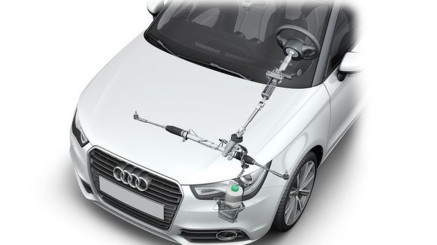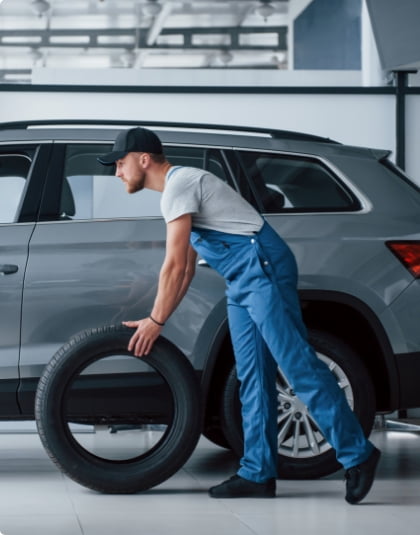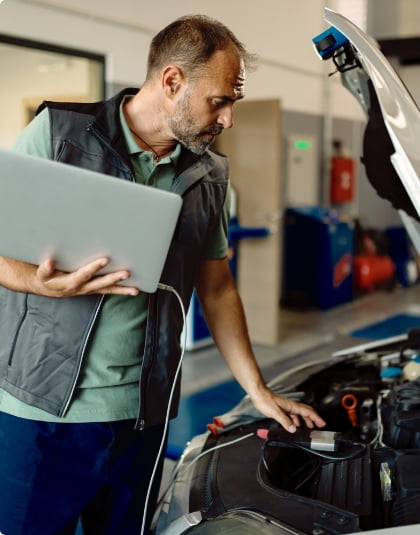How a Functional Steering Column Can Save Your Life

Ensuring the maximum safety of drivers and passengers is the primary goal pursued by automotive manufacturers worldwide. To protect their customers, automotive companies regularly enhance the active and passive safety systems of their vehicles.
Active safety systems prevent emergency situations on the road. Passive safety measures include devices and systems that reduce the risk of injuries in traffic accidents for both the driver and passengers.
This article focuses on the safe steering column shaft (a component of the steering system and a passive safety device), its design, and functions. We'll tell you who first designed the safe shaft and why it is crucial to always keep this component in good condition.
At the end of the article, we'll unveil the secret of dealing with steering column shaft failures.
Safe Shaft - Origin Story
The safe steering system was invented in 1952 by Hungarian designer Bela Bareni, who worked at the German automotive company Mercedes-Benz from 1939 to 1972. Bareni patented over 2000 inventions, with most relating to passive vehicle safety systems.
Bareni's idea was to design cars composed of three zones. The front and rear zones were called deformation zones, which, in case of an accident, absorbed the impact.
The passive safety measures proposed by Bareni aimed to minimize the consequences of an accident for the driver and passengers. Bareni's concepts were first implemented in the Mercedes-Benz W120 "Ponton" car.
The first production car equipped with passive safety systems was manufactured in 1959. The model was named Mercedes-Benz W111, becoming the first vehicle in history with a safe steering column shaft. Since then, the component has been modified and improved multiple times, but the general principles laid out by Bela Bareni in one of his works have endured to this day.
Construction and Operation Principle of the Safe Shaft
The modern car's safe steering column shaft consists of four elements:
- Upper universal joint or cross joint
- Multi-groove sleeve
- Multi-groove shaft
- Lower universal joint or cross joint
All components of the subsystem are made of durable and wear-resistant metal alloys.
How they produce the safe steering column shaft:
The shaft and sleeve with multi-groove mounts are cast in precise molds.
- The produced parts undergo hardening to ensure the durability of the component.
- Cooled parts are fitted together on a lathe and polished to increase metal resistance to corrosion and mechanical wear, giving the elements a commercial appearance.
- The shaft is pressed inside the sleeve using a specialized press.
- The assembled subsystem is tested on a diagnostic stand that assesses the degree of mobility and the load-bearing capacity of shaft elements.
- Then, universal joints (crosses) are pressed onto the seating points at the ends of the subsystem, securing the shaft to the steering column and steering gear.
- The subsystem undergoes another examination, and if necessary, it is painted.
Safe shafts differ in size and types of multi-groove connections, depending on the structural features of vehicles. Generally, the safe subsystem of the steering column shaft looks like this:
Safe shaft in a simple and complex form (e.g., due to impact)
In the mid-to-late 20th century, safe shafts were manufactured according to different principles, resulting in a wide variety of designs, which was also reflected in operational principles. Over time, the telescopic shaft, which we just discussed, replaced the "competitors." Now, the telescopic shaft is installed in all cars, regardless of the type of steering column.
Operation Principle of the Modern Safe Shaft
- If, during an accident, the impact acts on the steering gear, the shaft collapses like a telescope, absorbing the inertial force.
- If the shaft's collapse is not sufficient to completely absorb the impact, the steering column's structure comes into play. The safe steering column of the car is equipped with two crosses located at the ends of the safe shaft, connecting the steering shaft of the column and the distributor of the steering gear into one structure. The crosses connect the shafts of the subsystems at a slight angle (up to 15°) to each other. Thanks to this design, in the event of a strong impact, the column collapses instead of striking the driver's chest.
Angles between the column, safe shaft, and steering gear distributor
Technical information is complete. However, there is one more topic we haven't discussed: what to do if the safe shaft is damaged?
Repairing a Damaged Safe Steering Column Shaft
Recently, a video was posted on our YouTube channel, where we discussed the unique service of repairing a damaged steering column shaft using the example of a Ford Fiesta car. If someone hasn't watched or wants to refresh their memory, they can watch the video below or on our YouTube channel.
The service is called unique for a simple reason: besides us, no one in Europe performs such repairs. Other services offer to replace a faulty shaft but do not undertake repairs.
Why this service is unique only to us:
- We have the necessary specialized equipment and tools.
- Work of such complexity can only be carried out by an experienced auto mechanic who understands the exact structure of the shaft and knows where to look, what to tighten, and how to fix it.
- A new safe shaft costs 8-10 times more than repair. Other services simply do not find it profitable to provide this service. Why bother if you can earn more and not risk your reputation?
The service is also unique due to special warranty conditions: for the unique safe steering column shaft repair service, we provide a 6-month warranty with no mileage restrictions.
Rust and an inattentive driver are the main enemies of the safe shaft. For example, in winter, if you get into the car and don't remove snow from your shoes, the snow melts in the warmth, and the resulting water gets into the space behind the pedals, where the shaft is located. The subsystem rusts, becomes acidic, and wears out. You will know that the subsystem is damaged when:
- There is a crunching and knocking when turning the steering wheel.
- The steering wheel gets stuck in one position while turning.
NOTE! The safe shaft not only protects against the consequences of an accident but also compensates for the angle between the steering gear and the column. For the steering system to function correctly, and the car responds to the steering wheel, the shaft must move freely.
Consequences of a damaged safe shaft:
- You lose control of the car, and the vehicle behaves unpredictably.
- The steering wheel jams.
- The electric power steering on the column is disabled.
- The power steering (hydraulic or electric) is overloaded, and steering components wear out faster.
- Steering gear and column components rust.
- In the case of deep corrosion, multi-groove connections of the safe shaft are destroyed, and the subsystem's shaft hangs in the sleeve.
- In the case of deep corrosion, in the event of a traffic accident, the locked shaft may not collapse completely. As a result, the driver suffers severe injuries, and the column, which absorbed the impact's inertia, is severely damaged.
- Rust on the multi-groove connection of the safe shaft is one of the reasons for crunching during steering turns
And now, about the service. Unfortunately, we cannot fully disclose the secret and describe all stages of repairing a damaged shaft at STS, as it is a trade secret. However, we will talk about the main points:
- Initially, the service mechanic examines the condition of the steering components.
- If the steering wheel knocks or gets stuck due to rust on the shaft, the master disconnects the subsystem from the column and gear to send the shaft for repair.
- In the repair workshop, another mechanic disconnects the multi-groove connection of the shaft and cleans the subsystem elements from rust.
- Then, the shaft's multi-groove mounting points are lubricated and pressed on a special press machine.
- If rust has damaged the crosses, the master replaces the connecting elements with new ones, then assembles the safe shaft in the car.
If the multi-groove connection of the safe shaft is damaged due to deep corrosion, and repair is not advisable, the service master will suggest replacing the subsystem. However, to bring the shaft to this state, one must drive with a faulty subsystem for more than a month, enduring unpleasant crunching and knocking.
At the first signs of a steering column and entire steering system failure, we recommend contacting specialized auto services to protect yourself, your loved ones, and other road users from unforeseen incidents on the road.






